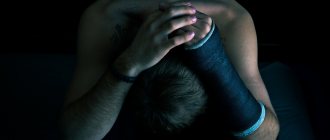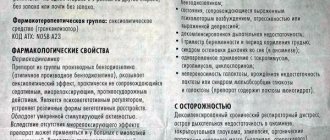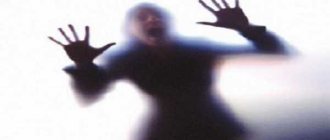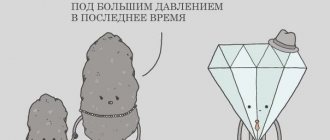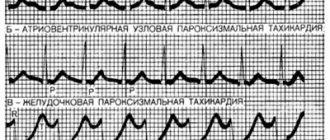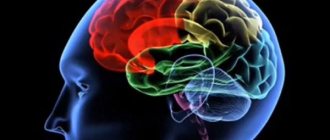Panic attack has many synonyms - autonomic dystonia, neurocirculatory dystonia, cardioneurosis, autonomic somatoform dysfunction. In the international classifier there is only a panic attack with the decoding that it is episodic paroxysmal anxiety. Disease code – F41.0.
During a panic attack, an imbalance occurs between two parts - the sympathetic and parasympathetic - of the autonomic nervous system. The disorder is reversible and functional. However, it is impossible to install this yourself. The manifestations of the disease are such that they resemble a lot of other organic or irreversible disorders.
In addition, a hypertensive crisis, some forms of epilepsy, heart disease and gastrointestinal tract disease, diabetes mellitus, and neurological disorders can occur under the guise of a panic attack. Therefore, treating panic attacks is a purely medical task, which is preceded by a good clinical examination.
How does a panic attack manifest?
A classic panic attack begins at night, when a person, after suddenly waking up, feels a surge of strength, it becomes easy to breathe, and a feeling of “opening” of the lungs appears. At the same time, intestinal peristalsis is clearly felt, and then horror and fear “covers”. If the attack comes during the day, it is somewhat weaker.
The heart begins to pound, there is a feeling of lack of air, it is impossible to breathe deeply, sweat profusely occurs, unsystematic dizziness occurs, a feeling of lightheadedness, “the ground disappears from under your feet.”
Patients often feel nauseous, chills or have a fever, and are disturbed by a feeling of unreality of what is happening. A person cannot control himself at such moments; fear takes over him completely.
The duration of the attack is from several minutes to an hour; longer attacks are rare. After finishing, the person is physically exhausted, there may be copious urine output or deep sleep.
In the long-term period of the attack, anxiety persists, the person is in constant anticipation of the next attack. Attacks become more frequent and more severe against the background of real or imagined troubles that a person has.
Qualified help
If you or your loved ones experience the first signs of PA, you should seek medical help. As a psychotherapist with many years of experience, I will relieve patients of their fears and perform all the necessary diagnostics for a correct diagnosis and quality treatment.
Having a wide profile allows me to identify panic attacks in children and adults at the first consultations and begin treatment in a timely manner. It is important to remember that by quickly recognizing the nature of PA, you can prevent their subsequent occurrence.
Drug treatment
Since the 90s of the last century, serotonin reuptake inhibitors (SSRIs) have been considered the first-line drugs for the treatment of panic attacks and anxiety disorders of other origins.
The mechanism of action is an increase in the amount of serotonin in the synaptic cleft, which leads to relief of depression and anxiety. The best drugs:
| Chemical name of the drug | Action |
| sertraline | Anti-anxiety effect combined with stimulating and sedative |
| fluoxetine | The most pronounced effect against anxiety, but has a withdrawal syndrome, the dose is reduced gradually |
| paroxetine | Quickly eliminates anxiety and insomnia, has little activation, is well tolerated |
| citalopram | It is better tolerated than others, but the full effect develops in 2 to 4 weeks |
| escitalopram | Useful for patients who develop panic attacks during alcohol withdrawal |
Other drugs - dapoxetine, indalpin, femoxetine - have a weaker effect and are not used in the Russian Federation.
Benzodiazepine tranquilizers - Librium, Phenazepam, Atarax, Frizium and others - complement the therapeutic effect. Medicines are used for a short course because they can become addictive and dependent.
In some cases, treatment is supplemented with minor antipsychotics - Eglonil, Sonapax and the like. This combination relieves various gastrointestinal distress well.
According to indications, symptomatic drugs are used - beta blockers, antihypertensive drugs that reduce dizziness or nausea.
During the first month, active drug treatment is carried out, maintenance can last for 6 or even 9 months. Along with medication, active psychotherapy is required, aimed at eliminating the cause of suffering. If treated only with medications, the patient will not be able to refuse them in the future, using medications as a “crutch” for his worries.
The Age of Anxiety and Depression Disorders
Why are panic attacks, depression, bipolar disorders and even schizophrenia popular nowadays?
Over the last century there have been certain peaks in fashion for mental disorders. At the end of the 19th and beginning of the 20th century, spleen, spleen, and the image of a romantic hero were relevant - this helped to stand out from the crowd. Afterwards there was a trend towards the teachings of Sigmund Freud, which caused a fashion for hysteria. Experiments began with psychotropic drugs and LSD. Then interest switched to the image of the model Twiggy - a fashion for anorexia and bulimia arose, which continues to this day.
Since the 1990s, narcissism has become popular. The image of a successful self-made man. And now a great demonstration of this is happening through Instagram stories. For example, famous people expose details of their intimate lives. The media and social networks help promote the image of a person who is always in high spirits, engages in self-admiration (selfies every three minutes) and endless self-realization, comments on everything, and participates in everything. This is the era of “effective efficiency” and “successful success”.
This prosperous image, as Sklyar says, corresponds only to a person with manic-depressive psychosis. “He has a frantic activity,” explains the doctor, “a minimum of sleep, a huge number of successful projects - and this is impossible. A person is limited in his capabilities, in the capabilities of the nervous system. Because of this imposed cult, many people, unfortunately, begin to suffer from anxiety and depressive disorders, because they can’t keep up with everything, they don’t live up to everything.” But there is something “wrong” with the person who is considered ideal, and not vice versa.
A mental disorder is a disorder, a specific combination of abnormal thoughts, beliefs, emotions, behaviors and relationships with others. But it turns out that the speed of life and the romantic aura around such illnesses force us to plunge ourselves into a state close to a real disorder, or mentally fuel its development. For example, at the slightest upset, say that you are depressed. Or before an important event, call anxiety panic. This is a very dangerous trend, says Sklyar.
Physiotherapy
A panic attack comes to those people who already have various neuroses. The basis, as a rule, is psychogeny - the traumatic impact of a situation or experience. The development of neurosis is adaptive in nature; the body thus adapts to an unpleasant situation.
Physiotherapy has great potential in treating panic attacks. This is the influence of natural forces - heat, cold, light, electric current, magnetic field and other factors.
The advantage of physiotherapy is the absence of chemicals with which the body of a sick person is already overloaded. All physiotherapeutic methods improve blood flow, excretion of metabolic products, and deepen sleep. Physiotherapeutic methods are pleasant, bring physical and sometimes aesthetic pleasure, and distract from painful experiences.
The following types of physiotherapy are used:
- Massage – restorative, preventive, segmental, acupressure. Exquisite types of massage - honey, chocolate, warm stones, snails, cacti, hot herbs. Each massage therapist has in his arsenal exotic techniques that suit the patient better than others.
- Water treatment - various types of shower: circular, Charcot, hydromassage, contrast. Regular swimming in a pool or water park can improve your well-being for a long period.
- The float chamber is a relatively new type of physiotherapy, put on a commercial basis. The device has another name - a sensory deprivation chamber. A person is in a capsule with heated water in which salts are dissolved. The weight of the body is not felt, the state of weightlessness is simulated. No signals from the outside world, including light or noise, are received. The patient has the opportunity to process all his experiences. Sleep after visiting a float chamber can last up to a day. The camera can be used at the final stage of treatment for panic attacks, when the main symptoms have been overcome.
- Exposure to electric current – darsalization of the head and neck, electrophoresis, electrosleep, various types of electrical stimulation.
- Magnetic procedures - the use of alternating or constant magnetic fields in continuous or pulsed mode. Magnetotherapy changes the properties of liquid media and accelerates recovery.
Hypnosis treatment
Necessary for those patients in whom the cause of a panic attack is deeply hidden in the subconscious or, for ethical reasons, cannot be voiced.
Hypnosis treatment for panic attacks is successful when performed by a certified professional. There are many scammers in this area, so using hypnosis is only safe within the walls of a licensed medical facility. The hypnologist must have a primary specialization in psychiatry or psychotherapy, in which case the treatment should bring results.
There are two main types of hypnosis used: traditional and Ericksonian.
Traditional hypnosis is suggestion in an altered state of consciousness. Induction into a trance is necessary to “pull out” the cause of anxiety. Most often, the cause is violence suffered in childhood, or elements of psychological bullying that were subsequently repressed from conscious life. Sometimes a banal strong fear, various childhood “horror stories”, false beliefs or painful family myths are revealed.
Processing such “brakes” from the subconscious allows a person to completely free himself from them, and subsequently recover from neurosis and panic attacks.
Ericksonian hypnosis is a softer method when immersion in a trance occurs during normal communication. This type of hypnosis bypasses protests if they exist in the patient's psyche. This technique eliminates the need to overcome the patient’s resistance.
It is useful to teach the elements of Ericksonian hypnosis to the patients themselves so that in the future they can independently engage in auto-training and self-hypnosis, without fear of the onset of new panic attacks.
The main method of getting rid of panic attacks is psychotherapy, which brings excellent results along with hypnosis.
Prognosis for recovery
The sooner you contact a medical facility, the better for the victim. In state psychoneurological dispensaries, which are located in every district, there are anonymous help rooms where you can get advice for free. In addition, there are private psychotherapists who, for a number of reasons, turn out to be more competent than specialists from the IPA. A psychotherapist must specialize in psychosomatics, have knowledge about the nature of panic disorder and the skills to eliminate it.
Psychotherapy methods
There are more than 450 types and methods of psychotherapy. Each specialist chooses from this variety those methods that are most suitable for the situation and personality of the patient.
The method is selected, first of all, from 2 varieties: directive and non-directive. Directive is consonant with dependent individuals who need a leader and guide. Good results from non-directive techniques should be expected in rational, educated and intelligent patients.
Great importance is attached to methods in which learning based on dialogue with the patient plays a leading role. Sometimes it is enough to analyze in detail the situation of anxiety and teach the simplest techniques for overcoming it in order for the patient to receive significant relief.
Interpersonal interaction between therapist and patient is important. There are situations when the doctor turns out to be the only adequate person and specialist from the entire patient’s environment who can suggest a rational way out of a traumatic situation.
Family therapy aimed at the correct distribution of gender role position is of great importance. This is extremely important for single-parent families with teenagers, and for married couples who are forced for financial reasons to live with their parents.
On this complex basis, many conflicts arise, often ending in the disintegration of marriages. The family constellation method helps each family member understand their true position and correct the situation while there is still time.
Body-oriented therapy
This technique is at the intersection of manual and psychotherapy. The therapist detects muscle tension and pain points on the patient’s body, while simultaneously clarifying their connection with traumatic events or circumstances.
Reducing anxiety levels occurs through the use of relaxation techniques and breathing exercises. The patient, together with the therapist, finds those muscle groups whose alternate tension and relaxation gives the best result.
Consistent work gradually destroys the protective shell with which the patient envelops himself after a collision with a hostile world.
This technique is particularly effective in cases of acute grief and fear of losing loved ones. Patients whose lives really lack stability become more confident and seem to gain support. Good results come from not accepting your own body. The techniques perfectly resist pain in different parts of the body, feelings of tension, and loss of sensitivity.
Sleep disorders, coordination problems, excess weight, and unconscious psychological trauma can be treated. As a result of classes, emotional imbalance decreases, a person becomes more open, learns to express his emotions, and defend his place in society.
Defending your territory
This is a huge problem for people suffering from panic attacks. Patients end up saying the same thing: they don’t have their own space in life, they are “ridden” by their relatives and employees, they don’t have the opportunity to be alone with themselves to sort out their own priorities.
The task of the psychotherapist is to explain through various methods the postulate that each person is valuable in himself, even if his life seems completely ordinary. In the process of psychotherapeutic work, a reassessment of values, a change in self-esteem, and awareness of one’s own importance occur.
People suffering from panic attacks often feel useless and burdensome to their family or friends. As a rule, these are people with an exaggerated sense of duty, “stuck” in infantilism. They took with them into adulthood teenage maximalism and a deep belief that nothing good was destined for them.
Personality restructuring is a long process that can take several years. However, such psychotherapeutic work leads to a complete revision of life position, internal transformation and a radical improvement in the quality of life.
Working with secondary benefits
Secondary benefit is the benefit that the patient intended to obtain during the period of formation of pathological symptoms. These are the unconscious dividends that a person receives from his fortune.
A classic example: a wife becomes “severely ill” at the moment when her husband decides to leave the family. Due to “illness” care is postponed indefinitely. This is a stalemate in which the wife will undergo more and more examinations, strengthening those around her in the idea that she needs help every day. The examination reveals almost complete health, but this is unlikely to stop the woman - unless she looks after a new husband along the way.
Secondary gain is an incredibly complex issue that requires true skill from the psychotherapist. If you manage to overcome it, a person can recover forever.
Author of the article: Psychiatrist, psychotherapist Larisa Vladimirovna Neboga
Symptoms
Typically, a depressive state is accompanied by a general decrease in performance, body endurance, bad mood, loss of interest in life, sleep and appetite disorders.
Panic depression is indicated by the occurrence of panic attacks. Panic attacks with depression manifest themselves in the form of an unpredictable, unreasonable, uncontrollable attack of fear, accompanied by symptoms such as:
- profuse sweating;
- increased heart rate;
- dizziness, severe nausea;
- severe chills;
- pain in the heart area, increased blood pressure;
- feeling of suffocation;
- a state close to fainting.
Other symptoms similar to those of some known diseases may also occur.
Panic, panic, panic
Panic disorder is characterized by the occurrence of panic attacks. For no reason, vegetative-vascular crises occur. There is no reason - it is useless to look for it. A panic attack appears out of nowhere. Any stress, physical illness and life situation that goes beyond the usual can trigger the disorder.
Sklar: “Panic attacks are the most popular mental disorders. This “successful success”, this standing on tiptoes, greatly exhausts a person’s resources. After all, we have a sympathetic and parasympathetic nervous system.”
To put it simply, there is the cerebral cortex and the so-called amygdala, the nucleus. “When some dangerous or life-threatening situation occurs, it begins to signal the body, which behaves in a certain way. Stress hormones are released: cortisol, norepinephrine, adrenaline. Those who have experienced a panic attack know what it is. When you are simply “sausage”. So much adrenaline is released into the bloodstream that you can’t handle it, and every physiological reaction you can imagine begins,” says Maya.
How to deal with these? According to Sklar, the best tactic is to do nothing. You need to survive a panic attack. No antidepressants help with panic attacks, auxiliary drugs do not affect anything. When adrenaline is released into the blood, the vessels react like this: they spasm.
Sklyar: “The body has about five liters of blood, the heart needs to pump it. It calmly pumps itself through a small hole. As soon as the vessel narrows, the heart needs to pump the same volume of blood through such a hole (shows a narrower hole - editor's note). What will happen to the heart? The heartbeat will increase. And people immediately think that something will happen to them. The blood vessels have narrowed, the heart is pounding, there is not enough air. The person begins to worry and breathe shallowly. In fact, less oxygen enters the blood. Here carbon dioxide begins to predominate, which enters the amygdala and stimulates it. And everything else starts.”
To make it easier, you just need to sit down, relax and breathe deeply. Drugs will only perpetuate this “vicious” circle. “Panic attacks can be treated in three sessions and without drugs,” added the psychotherapist. And they arise mainly at a young age.
* A panic attack is not at all dangerous (this is a normal physiological state of a person).
* You won't be able to run away (any actions you take are useless).
* It makes sense to deliberately get into situations that cause panic (if we are afraid of the elevator, we ride in the elevator).

